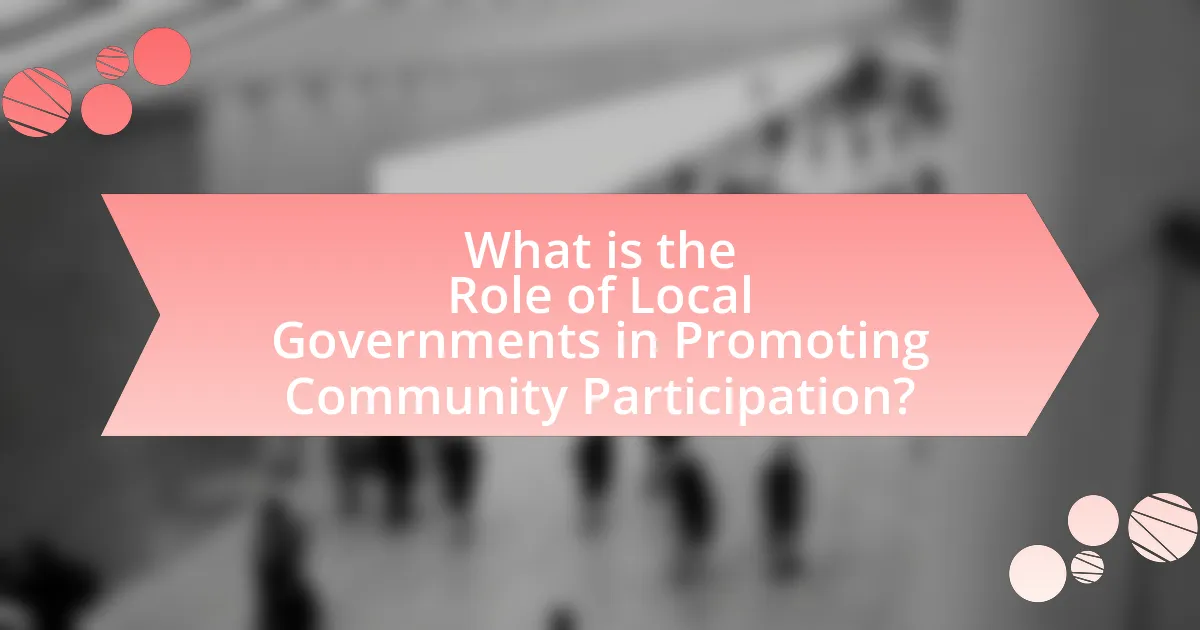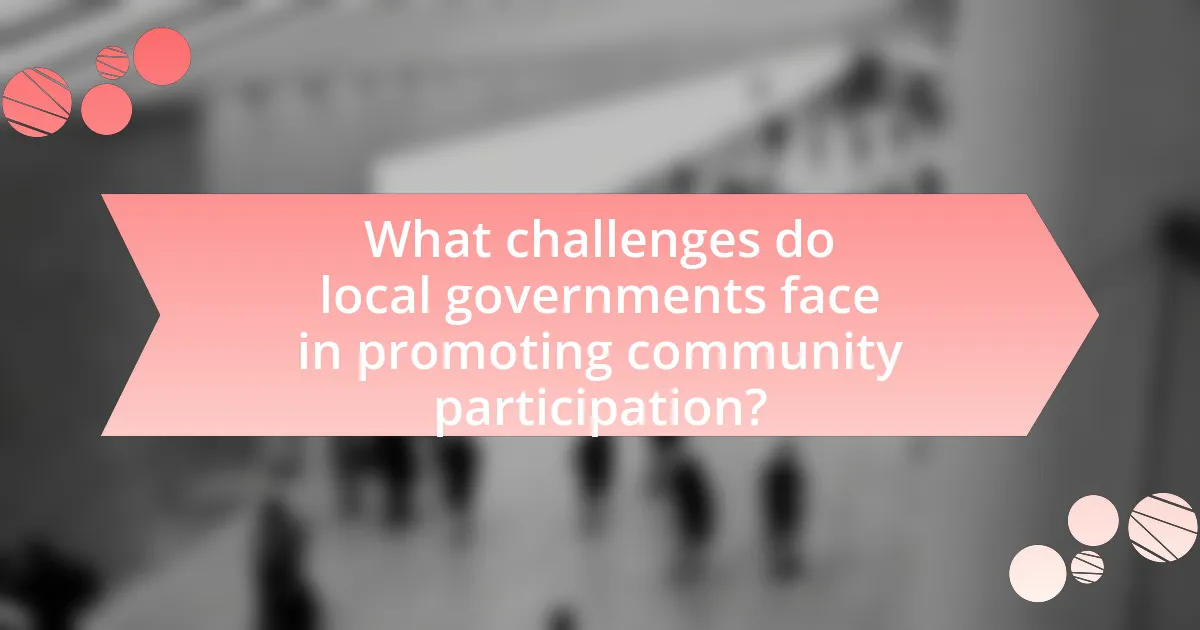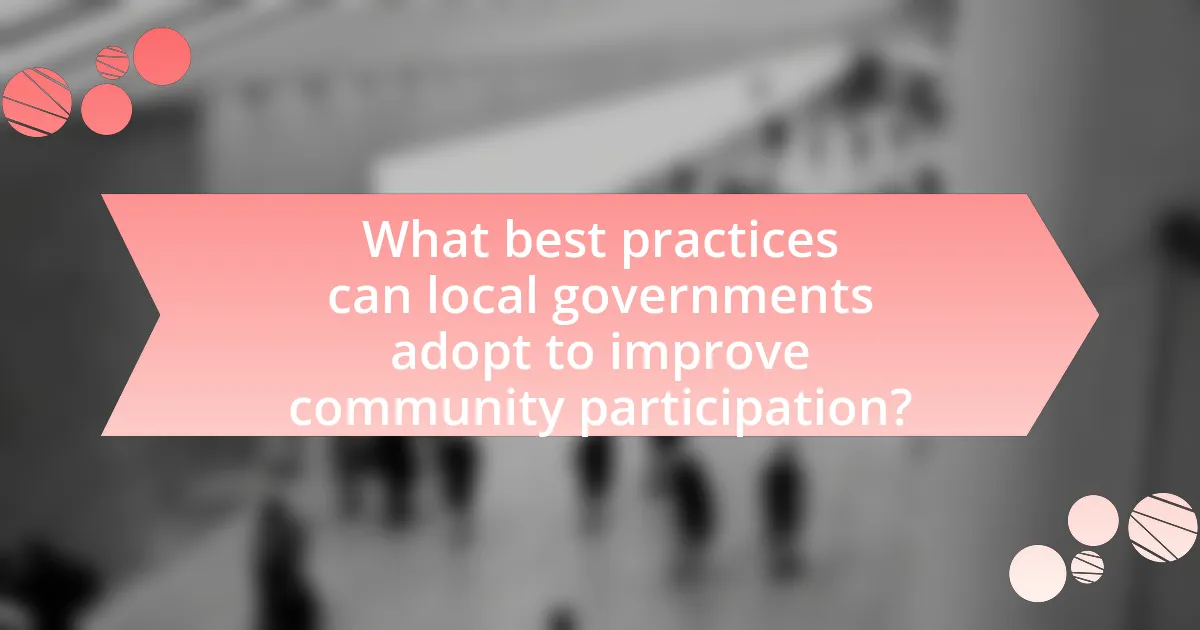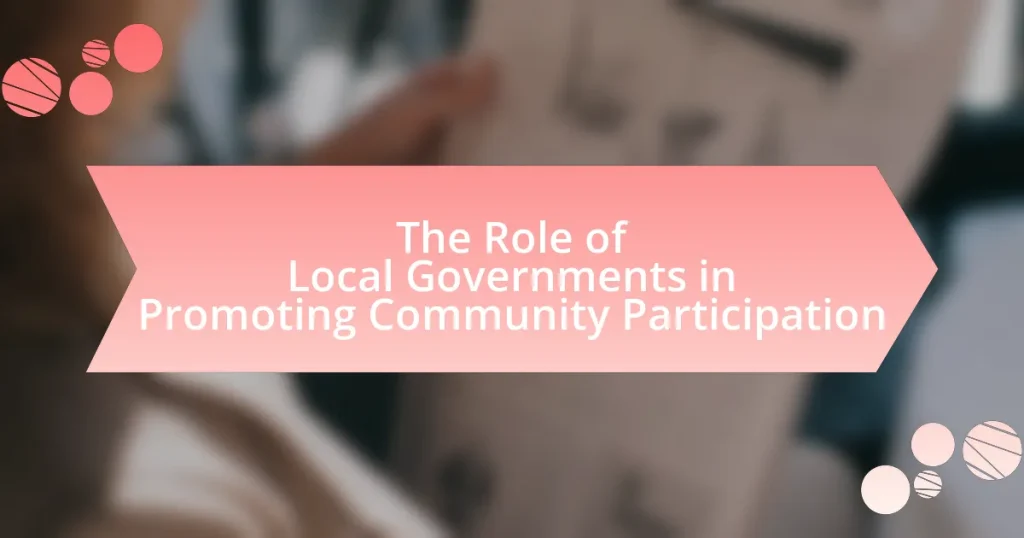Local governments play a vital role in promoting community participation by facilitating citizen engagement in local decision-making processes. They employ various strategies such as public consultations, community forums, and participatory budgeting to empower residents and enhance democratic governance. The article explores how local governments assess community needs, the importance of participation for effective governance, the challenges they face, and the impact of technology on engagement efforts. Additionally, it highlights best practices for fostering inclusivity and collaboration with community organizations and local businesses to strengthen civic involvement.

What is the Role of Local Governments in Promoting Community Participation?
Local governments play a crucial role in promoting community participation by facilitating engagement between citizens and local decision-making processes. They achieve this through various mechanisms such as public consultations, community forums, and participatory budgeting, which empower residents to voice their opinions and influence local policies. For instance, a study by the International City/County Management Association found that communities with active local government engagement initiatives reported higher levels of citizen satisfaction and trust in government. This demonstrates that local governments not only serve as a bridge between the community and policy-makers but also enhance democratic governance by fostering an inclusive environment for participation.
How do local governments facilitate community engagement?
Local governments facilitate community engagement by implementing various strategies such as public meetings, surveys, and participatory budgeting. These methods allow residents to voice their opinions, contribute to decision-making processes, and influence local policies. For instance, a study by the International City/County Management Association found that communities with regular public forums saw a 30% increase in citizen participation in local governance. Additionally, local governments often utilize digital platforms to reach a broader audience, enhancing accessibility and encouraging diverse participation.
What strategies do local governments use to encourage participation?
Local governments use various strategies to encourage participation, including community engagement initiatives, public forums, and outreach programs. These strategies aim to foster a sense of belonging and empower residents to voice their opinions. For instance, local governments often organize town hall meetings to facilitate direct dialogue between officials and community members, allowing for feedback on policies and projects. Additionally, they may implement online platforms for surveys and discussions, making participation more accessible. Research indicates that communities with active local government engagement see higher rates of civic participation, as evidenced by a study from the International City/County Management Association, which found that 70% of residents felt more connected to their community when involved in local decision-making processes.
How do local governments assess community needs and interests?
Local governments assess community needs and interests through various methods, including surveys, public meetings, and community engagement initiatives. These approaches allow local officials to gather direct feedback from residents, ensuring that the services and programs they implement align with the community’s priorities. For instance, a study by the International City/County Management Association found that 70% of local governments utilize surveys to gauge public opinion, highlighting the importance of structured feedback mechanisms in understanding community dynamics.
Why is community participation important for local governance?
Community participation is crucial for local governance because it enhances democratic processes and ensures that the needs of residents are effectively addressed. When community members engage in decision-making, they contribute valuable insights that reflect local priorities, leading to more relevant and effective policies. Research indicates that areas with higher levels of community involvement often experience improved public services and increased trust in local authorities, as evidenced by a study from the International Journal of Public Administration, which found that participatory governance models lead to better outcomes in service delivery and citizen satisfaction.
What are the benefits of community involvement in decision-making?
Community involvement in decision-making enhances the effectiveness and legitimacy of local governance. Engaging residents fosters a sense of ownership and accountability, leading to decisions that reflect the community’s needs and values. Research by the International Association for Public Participation indicates that inclusive decision-making processes improve public trust and satisfaction, as citizens feel their voices are heard and considered. Additionally, studies show that community input can lead to more innovative solutions, as diverse perspectives contribute to problem-solving. Overall, community involvement not only strengthens democratic practices but also results in more sustainable and accepted outcomes.
How does community participation enhance local governance effectiveness?
Community participation enhances local governance effectiveness by fostering transparency, accountability, and responsiveness in decision-making processes. When community members actively engage in governance, they provide valuable insights and feedback that help local authorities understand the needs and priorities of the population. This engagement leads to more informed policy-making and resource allocation, ultimately resulting in services that better meet community demands. Research indicates that areas with higher levels of community involvement report increased satisfaction with local governance and improved public trust, as evidenced by a study conducted by the World Bank, which found that participatory governance initiatives can lead to a 20% increase in citizen satisfaction with local services.

What challenges do local governments face in promoting community participation?
Local governments face several challenges in promoting community participation, including limited resources, lack of awareness, and bureaucratic barriers. Limited financial and human resources hinder the ability of local governments to effectively engage with the community, as they may not have the budget or staff to organize outreach programs. Additionally, a lack of awareness among community members about the importance of participation can lead to low turnout and engagement in local initiatives. Bureaucratic barriers, such as complex regulations and procedures, can further discourage community involvement by making it difficult for residents to navigate the participation process. These challenges collectively impede the effectiveness of local governments in fostering an inclusive participatory environment.
How do resource limitations affect community engagement efforts?
Resource limitations significantly hinder community engagement efforts by restricting the availability of funding, personnel, and materials necessary for effective outreach and participation. When local governments face budget cuts or limited financial resources, they often reduce programs aimed at fostering community involvement, leading to fewer opportunities for residents to engage in decision-making processes. For instance, a study by the National League of Cities found that 70% of local governments reported budget constraints as a barrier to effective community engagement initiatives. This lack of resources can result in diminished outreach efforts, reduced capacity for organizing events, and limited access to information, ultimately disengaging community members and undermining the effectiveness of local governance.
What role does funding play in supporting community participation initiatives?
Funding is essential for supporting community participation initiatives as it provides the necessary resources for planning, implementation, and sustainability. Local governments often allocate budgets to facilitate community engagement activities, ensuring that residents have the tools and opportunities to participate effectively. For instance, a study by the National Endowment for the Arts found that communities with dedicated funding for participatory projects saw a 30% increase in citizen involvement compared to those without such financial support. This demonstrates that adequate funding not only enhances the quality of initiatives but also fosters a culture of active participation among community members.
How can local governments overcome barriers to participation?
Local governments can overcome barriers to participation by implementing inclusive outreach strategies that engage diverse community members. These strategies include utilizing multiple communication channels, such as social media, community meetings, and local events, to reach various demographics effectively. Research indicates that when local governments actively seek input from underrepresented groups, participation rates increase significantly; for example, a study by the International City/County Management Association found that targeted outreach efforts can boost engagement by up to 40%. Additionally, providing resources such as translation services and accessible meeting locations further facilitates participation, ensuring that all community members have the opportunity to contribute to local governance.
What are the impacts of technology on community participation?
Technology significantly enhances community participation by facilitating communication, increasing access to information, and enabling collaborative platforms. Digital tools such as social media, community apps, and online forums allow residents to engage with local government initiatives and each other more effectively. For instance, a study by the Pew Research Center found that 70% of adults in the U.S. use social media to connect with their communities, demonstrating how technology fosters greater involvement. Additionally, platforms like Nextdoor and local government websites provide residents with real-time updates and opportunities to voice their opinions, thereby increasing civic engagement and participation in local decision-making processes.
How can digital platforms enhance engagement with local governments?
Digital platforms can enhance engagement with local governments by facilitating real-time communication and feedback between citizens and officials. These platforms, such as social media, mobile apps, and dedicated websites, allow local governments to disseminate information quickly and gather public input on policies and initiatives. For instance, a study by the Pew Research Center found that 70% of Americans believe social media can be an effective tool for local governments to engage with their communities. This direct interaction fosters transparency, encourages civic participation, and helps local governments respond more effectively to the needs and concerns of their constituents.
What challenges do local governments face in using technology for participation?
Local governments face several challenges in using technology for participation, including digital divide issues, limited resources, and resistance to change. The digital divide creates disparities in access to technology among community members, which can hinder inclusive participation. Limited financial and human resources restrict local governments’ ability to implement and maintain technological solutions effectively. Additionally, resistance to change from both government officials and community members can impede the adoption of new technologies, as stakeholders may be hesitant to shift from traditional methods of engagement. These challenges collectively impact the effectiveness of technology in enhancing community participation.

What best practices can local governments adopt to improve community participation?
Local governments can improve community participation by implementing inclusive engagement strategies. These strategies include hosting regular town hall meetings to gather input, utilizing digital platforms for broader outreach, and forming advisory committees that represent diverse community interests. Research indicates that communities with active participation mechanisms see a 30% increase in civic engagement, as reported by the National Civic League. Additionally, providing training for community leaders enhances their ability to facilitate discussions, fostering a more participatory environment.
How can local governments build trust with community members?
Local governments can build trust with community members by engaging in transparent communication and actively involving residents in decision-making processes. For instance, regular town hall meetings and open forums allow community members to voice their concerns and provide input on local issues, fostering a sense of ownership and collaboration. Research from the International City/County Management Association indicates that communities with higher levels of public engagement report increased trust in local government. Additionally, implementing feedback mechanisms, such as surveys and suggestion boxes, demonstrates that local governments value community input, further enhancing trust.
What communication strategies are effective in fostering participation?
Effective communication strategies for fostering participation include active listening, clear messaging, and inclusive dialogue. Active listening ensures that community members feel heard and valued, which encourages their involvement. Clear messaging simplifies complex information, making it accessible and understandable, thereby increasing engagement. Inclusive dialogue invites diverse perspectives, fostering a sense of belonging and ownership among participants. Research by the International Association for Public Participation highlights that these strategies significantly enhance community involvement in local governance initiatives.
How can local governments ensure inclusivity in their engagement efforts?
Local governments can ensure inclusivity in their engagement efforts by actively involving diverse community members in decision-making processes. This can be achieved through targeted outreach initiatives that identify and engage underrepresented groups, such as minorities, low-income residents, and individuals with disabilities. For instance, a study by the National League of Cities found that cities implementing inclusive engagement strategies saw a 30% increase in participation from marginalized communities. Additionally, utilizing multiple communication channels, such as social media, community meetings, and surveys, allows for broader access and input from various demographics. By prioritizing transparency and creating safe spaces for dialogue, local governments can foster an environment where all voices are heard and valued.
What role do partnerships play in enhancing community participation?
Partnerships play a crucial role in enhancing community participation by fostering collaboration between local governments, community organizations, and residents. These partnerships create a platform for shared resources, knowledge, and expertise, which can lead to more effective engagement strategies. For instance, research conducted by the International Association for Public Participation highlights that communities involved in partnerships with local governments report higher levels of trust and satisfaction, resulting in increased participation in civic activities. This collaborative approach not only empowers residents but also ensures that diverse voices are heard, ultimately leading to more inclusive decision-making processes.
How can local governments collaborate with non-profits and community organizations?
Local governments can collaborate with non-profits and community organizations by establishing formal partnerships that leverage resources and expertise. These collaborations can include joint initiatives, funding opportunities, and shared programs aimed at addressing community needs. For instance, a study by the National League of Cities highlights that local governments often provide grants and technical assistance to non-profits, enabling them to implement community-driven projects effectively. Additionally, local governments can engage in regular communication and planning sessions with these organizations to align goals and strategies, ensuring that community participation is maximized and that services are delivered efficiently.
What are the benefits of engaging local businesses in community initiatives?
Engaging local businesses in community initiatives fosters economic growth and strengthens community ties. Local businesses often contribute resources, expertise, and funding, which enhances the effectiveness of community programs. For instance, a study by the American Independent Business Alliance found that local businesses reinvest approximately 70% of their revenue back into the local economy, compared to only 43% for national chains. This reinvestment supports job creation and local services, ultimately benefiting the community’s overall well-being. Additionally, collaboration between local businesses and community initiatives can lead to increased visibility and customer loyalty for the businesses involved, creating a mutually beneficial relationship that promotes sustainable community development.
What practical steps can local governments take to encourage community participation?
Local governments can encourage community participation by implementing inclusive outreach programs that actively engage residents in decision-making processes. These programs can include town hall meetings, surveys, and workshops designed to gather input on local issues, ensuring that diverse voices are heard. For instance, a study by the International City/County Management Association found that communities with regular public forums saw a 30% increase in citizen engagement compared to those without such initiatives. Additionally, local governments can establish advisory boards that represent various community demographics, fostering a sense of ownership and responsibility among residents. By providing accessible platforms for dialogue and feedback, local governments can effectively enhance community involvement and collaboration.
